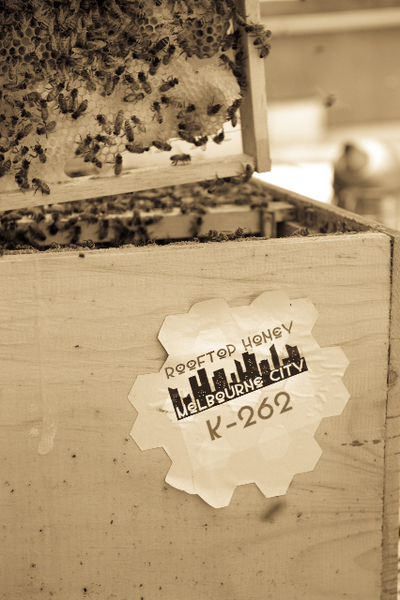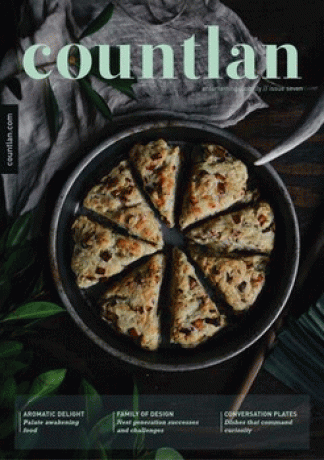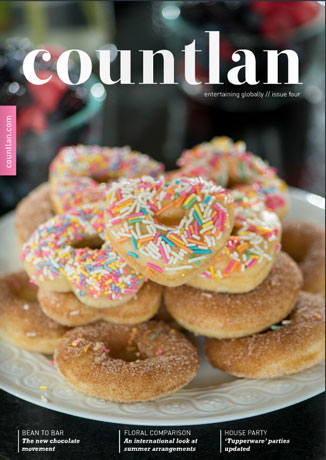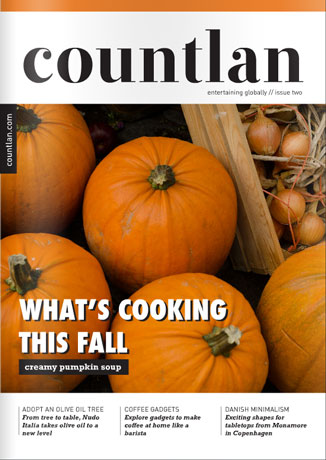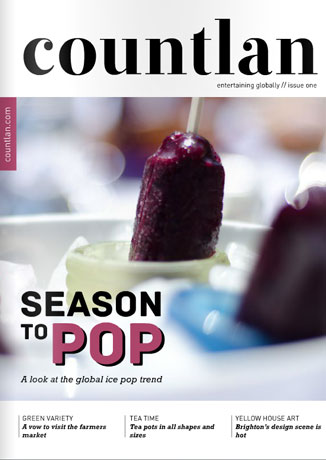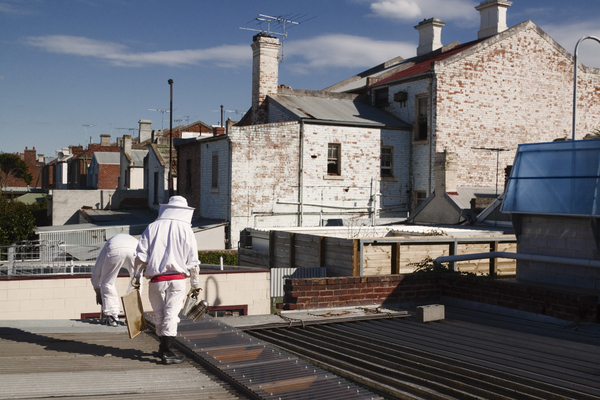
Rooftop Honey Melbourne
What Vanessa Kwiatkowski calls “a moment of clarity” led her and her partner Mat Lumalasi to launch Melbourne City Rooftop Honey, a project that cultivates honey from beehives located on underused rooftops around the city. Fuelled by concerns over food production and the worldwide decline of bees, Vanessa — an avid gardener already accustomed to growing her own food — saw the project as an opportunity to raise awareness of the various threats and diseases that put honeybees at risk.
By offering hive adoptions and sponsorships, along with partnering with local restaurants, Melbourne City Rooftop Honey connects people, food, sustainability, collaboration, and community. “We encourage people to get involved in any way possible,” says Vanessa. “We teach people about bees and how to keep their own hive, and encourage the general public to plant bee-friendly plants to attract bees and supply food for them.” Currently, Vanessa and Mat oversee 73 hives in the city where they install, maintain, and care for the hives using natural beekeeping methods.
INTERVIEW, Vanessa Kwiatkowski, Co-Founder Melbourne City Rooftop Honey, Melbourne
01 Why locate hives on top of Melbourne roofs?
Rooftops are a preferable spot to place hives as roofs are often under-used spaces. Placing a hive on top of a building does not interfere with bee travel to and from the hive and the location is perfectly safe for the public below, who usually don’t realise there are hives up above. We install, maintain and care for the bees using natural beekeeping methods. All of the hives have been re-homed from caught swarms by us. Each hive is checked approximately every 10 -14 days in the season– during the winter months we generally leave the bees alone after we are confident they have enough stores to survive the season. Currently we have more than 400 individuals and businesses wanting to get involved by adopting and or sponsoring a hive.
02 Why urban honey?
For the city, honey bees are especially important for pollination in Victoria, as we do not have any native, social forming colonies of bees, only solitary native bee varieties. Although it has a shorter season for beekeeping than other warmer states, Melbourne offers great diversity of nectar and pollen for our bees. You can find a mix of natives and European flora which means there is almost always something for our bees to forage on. Our hives, which are located in the CBD, are thriving and living proof that urban honey works. For example, Bourke Street in the CBD was the first hive we harvested and it produced a full box of honey was left in winter.
Urban honey is also quite unique in and of itself. It is known as poly-floral honey as bees travel approximately 3-5km from their hive. So their honey is a reflection of the flora in the area they forage –For example in Paris, after analyzing honey it was discovered that the honey contained more than 250 different pollens. In the countryside there can be as few as 15 or 20 different pollens. Like humans, a varied diet = healthy bees. The other interesting thing about urban honey is that its flavour changes throughout the season as flowers finish and new sources of nectar start. Urban bees benefit from the variety of flora growing in a city in contrast to what can be bound in the countryside, which often has just one crop dominating an entire area (monoculture). When the countryside field has finished blossoming, there is no more nectar for the local bees in that area.
Looking to the future, as we expand how we grow food in cities and work on making them cooler, greener and more sustainable, it will be vital to protect honey bees and include them in our cities and sprawling urban landscapes.
03 What type of education/information is missing for consumers when it comes to buying honey?
Some commercial honey practices ultra filter and heat treat their honey which results in an end product that is not actually honey. It’s more like honey-flavoured syrup. We always recommend that consumers get to know their local beekeepers or go to a farmers market and meet the folks behind the honey they purchase. Beekeepers will be able to tell you where the honey is from and how it is processed and whether the honey has been heated. Consuming raw or at least honey which has not been heated over 45 degrees is best. The other piece of information, which is more important for beekeepers but might be interesting for consumers, is do not feed bees sugar. Instead, let them eat the honey they work so hard for.
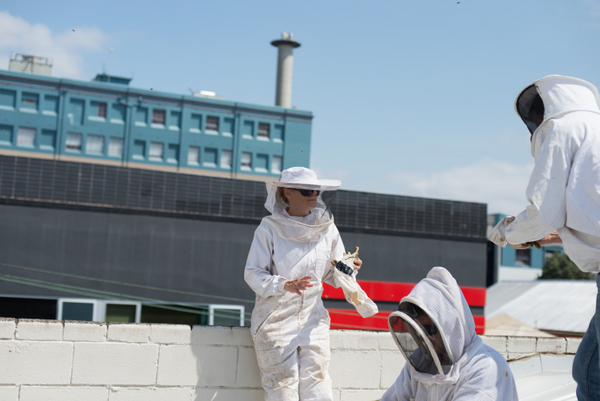
Photo Source (1-3) Justin Emerson
04 Can you talk about the values of your brand?
Our brand is about connecting people, food, sustainability, collaboration and community.
We encourage people to get involved with out brand any way possible. We try to teach people about bees, how to keep their own bees, we also encourage the general public to plant bee friendly plants to attract bees to their gardens and supply food for the bees. For the people who want to get involved, we have the two options of sponsorship and adoption. Sponsorship is the system that involves a yearly maintenance fee, which goes towards the servicing of the bees during the honey season. We supply everything and the sponsor receives a honey share percentage of the total honey harvested. Adoption is basically the same, but for people who are not in a position to be able to pay the annual fee (i.e. Community gardens)
We use social media as a platforms such as Facebook and Twitter to engage, educate and build community & have a good following. We also host events, public screenings of documentaries, presentations to groups i.e. gardeners,schools, environmental & sustainability groups. We welcome anyone who is interested in hearing about our work and the importance of bees.
05 What was the most significant thing you learned about honey or bees from launching Melbourne City Rooftop Honey?
We have had huge acceptance for our project. The main challenges (and learning points) included convincing owners to let us have bees in the vicinity of the public. We learned if we pointed out the common misconception of bees needing to be isolated for safety and hosted a site visit, it would alleviate hesitation and questions. It was about teaching people that bees are reasonably gentle creatures and not the crazed stinging predators. We also learned that working with bees reminds us to slow down and take your time. Trying to rush through the hive will result in unhappy bees; keeping bees is almost therapeutic.
Finally, there is learning about the impact of the weather on bees which can pose challenges. It is either too cold for the bees or it is too hot for bees and humans in those suits!

Photo Source: Lachie Mathison
06 What is your favourite way to eat honey?
Simply straight up, as is. However we also like to explore honey pairings. Cheese and honey pairs really well, especially goat, brie and blue cheeses. We use honey at home as a substitute for refined sugar in cooking, especially in favourites like Panna cotta. We also use it in our own ice cream, marinades, salad dressings and on good old fashioned honey on crumpets or toast.
Recipes with Honey:
- Bakepedia: Buckwheat Honey Ice Cream
- Alana Bread: Goat Curd + Honey Ice Cream
- A Sweet Simple Life: Honey-Almond Ice Cream
- Tiny Farmhouse: Blood Orange and Goat Cheese Salad
- Red Shallot Kitchen: Cucumber Salad with Cilantro Lime Honey Dressing
- Finger, Fork, Knife: Quinoa with Fennel, Tangelo, Avocado and Herbs
- Chew Town: Homemade Crumpets
- What Should I Eat for Breakfast: English Crumpets
- Adeline & Lumiere: Coconut Crumpets


